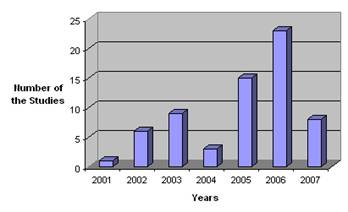Asia-Pacific Forum
on Science Learning and Teaching, Volume 11, Issue 2, Article 12 (Dec., 2010) |
In the present study, the grand mean for 65 ESs included 52 studies was 1,12. This effect size can be interpreted as an average student exposed to CAI exceeds the academic achievement of 87% of the students who were thought using other methods. In other words, the typical studentís achievement moved from the 50th percentile to the 87th percentile in science education when CAI was used.
This finding is consistent with Bayraktarís (2001-2002) study. The author found an overall effect size of 0.273 was calculated from 42 studies in secondary and college science education in the United States between 1970 and 1999. Similarly, in an earlier study, Christmann and Badget (1999) reported an effect size of 0.266 standard deviations when they synthesized the results of 11 studies comparing the effectiveness of CAI and traditional instruction in science. Liao (2007) also calculated positive effect size (ES=0.55) from 52 studies including all disciplines not only science, which favored CAI in Taiwan. The present study has larger effect size than these earlier studies.
This mean can also be interpreted as a large ES, since an effect is said to be medium when ES=0.5 and large when ES=0.8 (Cohen, 1977). It is an important result, with not only a large level grand mean effect size, but also 97% of all ESs favored of CAI.
Six variables were investigated for each study in the meta-analysis. For the publication year variable, there was no significant difference of the mean ES. For the years variable, approximation of the mean ES values can be seen in Table 2. Firstly, we aimed to investigate the range of 2000-2007 years. Since we have not met any studies reported in 2000, the range of the studies was defined as 2001-2007.
The relationship between number of studies and years was a remarkable result in the study (Figure 1). It could be said that number of the studies of computer assisted science education have increased almost constantly from 2001 to 2006 in Turkey. A decreasing of number of the studies reported in 2007 is illusive, because the period of data collection was from March to August of 2007; and at the end of 2007, studies will amount to more than in 2006 will be reported. These results reveal that the number of the studies on CAI will seemingly increase in the future in Turkey.
Figure 1. Relationship between number of studies and years
Another variable was type of publication. In the study, 52.3% of studies were located from journals, 26.2% of studies were located from dissertation/theses and 21.5% of studies were located from conference papers. However dissertation/thesis has larger mean ES than the others; there is a small difference among journal articles, dissertation/thesis and conference papers of mean ES in Turkey. Liao (2007) in Taiwan and Bayraktar (2001-2002) in United States found similar results.
The present meta-analysis detected significant differences in effectiveness for different grade levels. The results indicated that the most effective grade level was elementary (4th-8th) in Turkish computer assisted science instruction, followed by the university level. The most ineffective was the secondary (9th-12th) level. The ineffectiveness of the ES at secondary level (9th-12th) is probably due to the fact that these graders have to study very hard for a nationwide university entrance examination in Turkey, and using computer assisted instruction may not be a sensible approach for this aim. Liao (2007) also found the smallest ES at high school (10th-12th) and interpreted it because of nationwide college-entrance-examination. Bayraktar (2001-2002) did not find differences between secondary and college levels on CAI in science.
However, significant difference among the ES of subject areas was not pointed out in the study; the largest mean effect was found for physics then chemistry and biology. Literature shows that CAI is more effective in physics than in other subjects. Christmann and Badget (1999), by synthesizing the results of 11 studies, concluded that CAI is most effective in general science (ES=0.707), followed by physics (ES=0.280), chemistry (ES=0.085) and biology (ES=0.042). Bayraktar (2001-2002) calculated the mean ES for physics, general science, biology and chemistry respectively as 0.555, 0.335, 0.167, and 0.108. It is generally known that physics has many theoretical and abstract concepts that are difficult to understand by students. It can be said that CAI in physics courses is more effective than the other subject areas of science owing to this property of physics.
For the instruction method, the mean comparison of studies with traditional instruction group was significantly higher than studies in which the comparison groups were laboratory based, constructivist (7E) and others. In other words, CAI is more effective than traditional instruction compared to the other instruction methods in Turkish science education.
The last variable sample size was investigated in present meta-analysis. Although no significant difference was found among the mean ES on sample sizes, the largest mean ES was associated with studies with small sample size (1Ė40). This result can be interpreted as CAI on studentsí achievement is more effective for a small sample size in Turkey.

